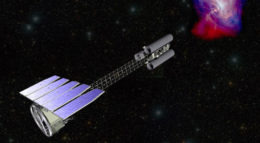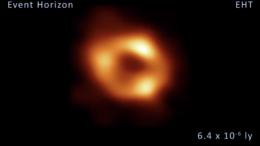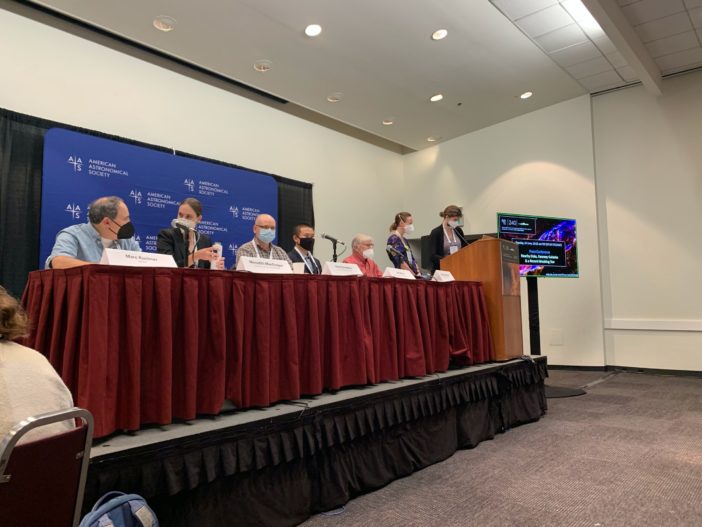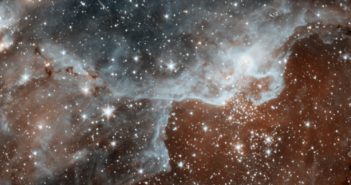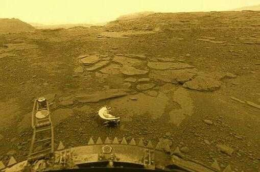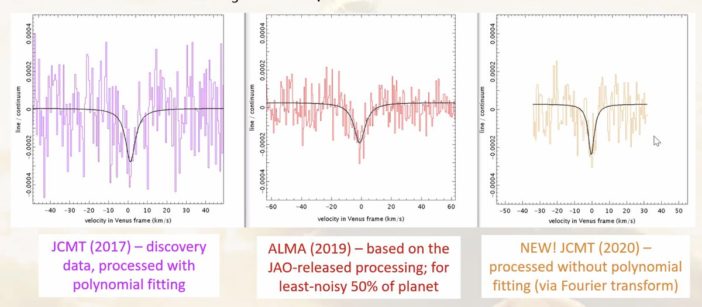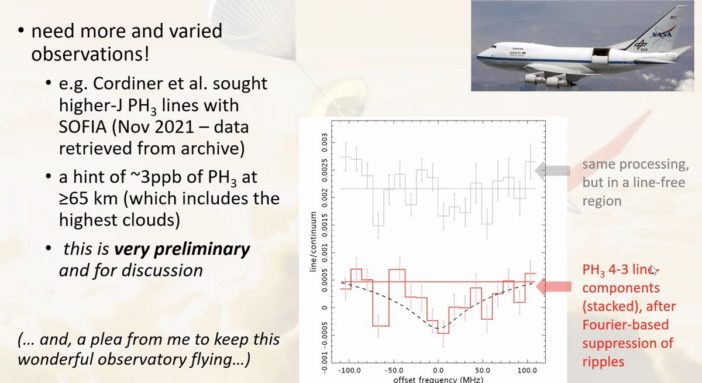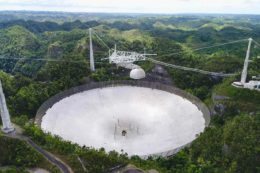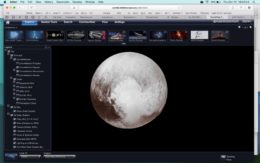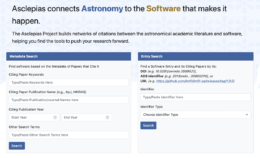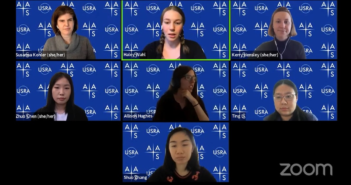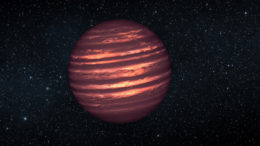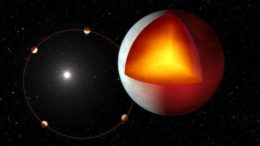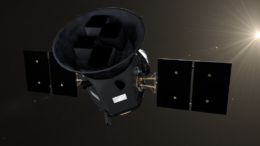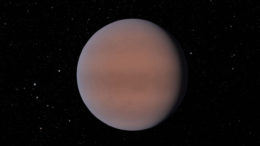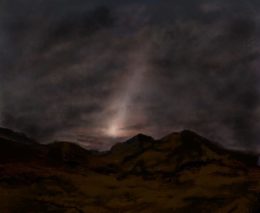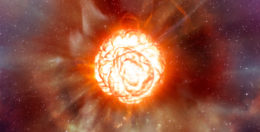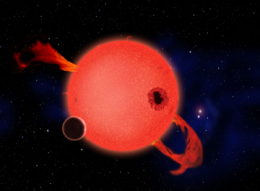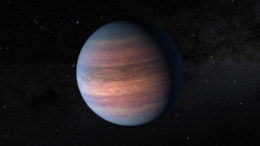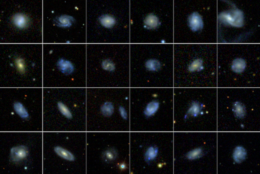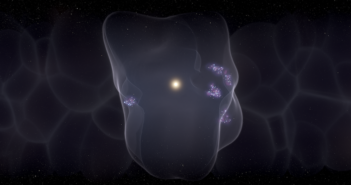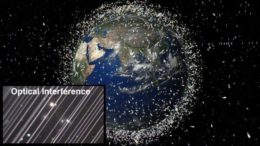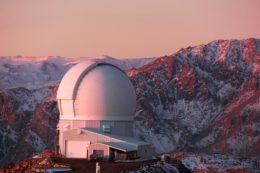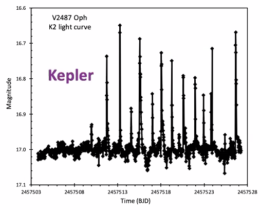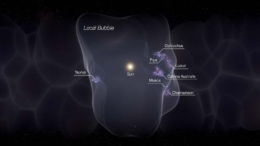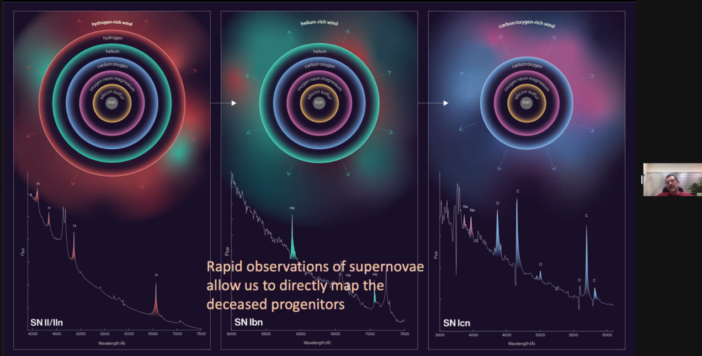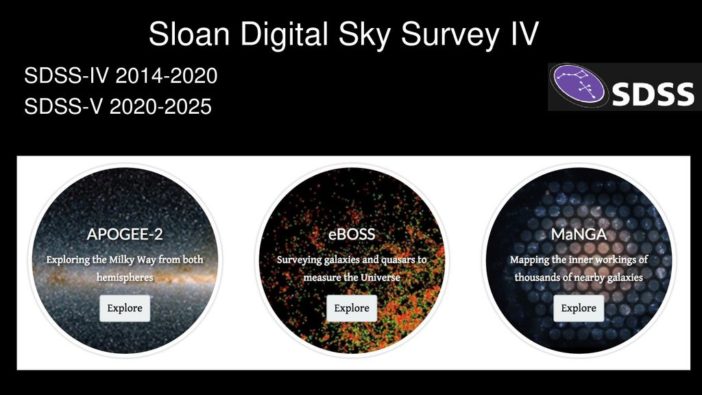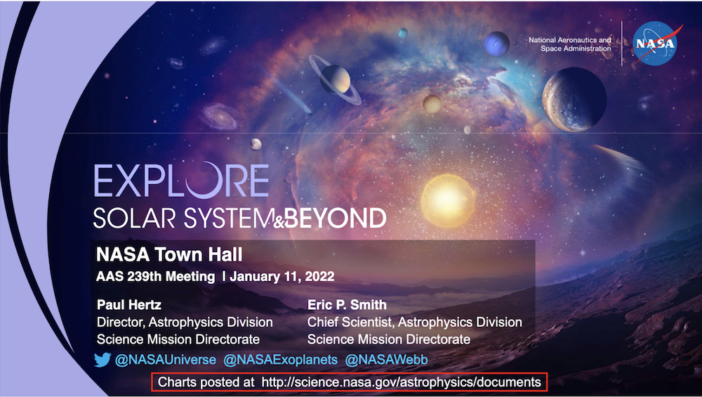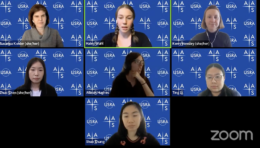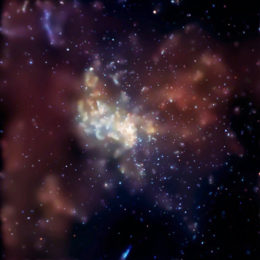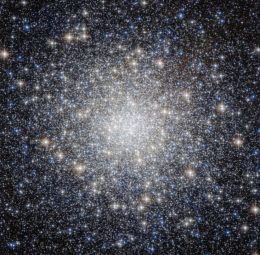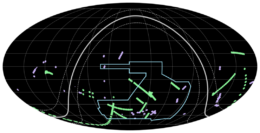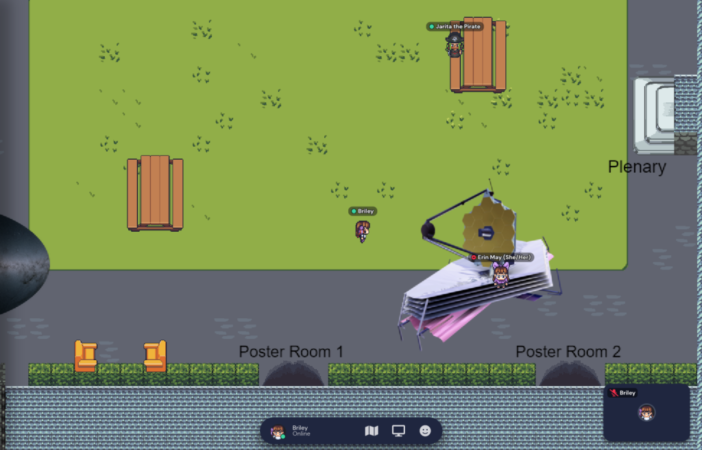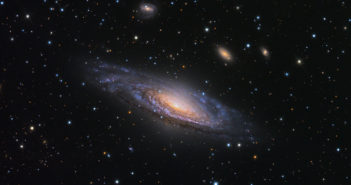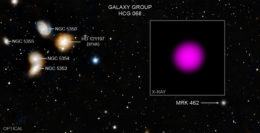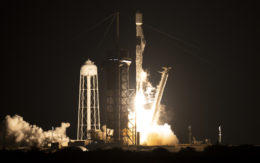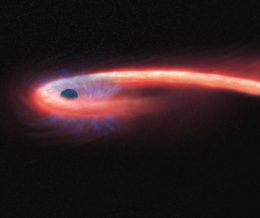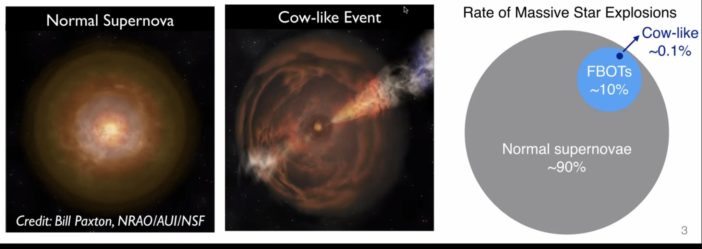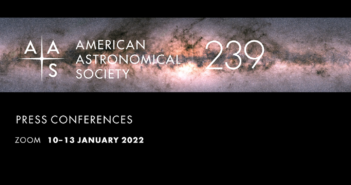
AAS 240: Day 2
Editor’s Note: This week we’re at the 240th AAS meeting in Pasadena, CA, and online. Along with a team of authors from Astrobites, we will be writing updates on selected events at the meeting and posting each day. Follow along here or at astrobites.com for daily summaries, or follow @astrobites on Twitter for live coverage. The usual posting schedule for AAS Nova will resume on June 21st.
Table of Contents:
- Historical Astronomy Divison Doggett Prize: William Donahue (St. John’s College / Green Lion Press)
- Imaging X-ray Polarimetry Explorer: Initial Results
- Imaging the Nearest Supermassive Black Hole, Sgr A*, with the Event Horizon Telescope
- Press Conference: Nearby Disks, Faraway Galaxies & a Record-Breaking Star
- Plenary Lecture: Thomas Zurbuchen (Associate Administrator, NASA Science Mission Directorate)
- Press Conference: Galactic Neighbors & Insights from ALMA
- Henry Norris Russell Lecture: Nicholas Scoville (Caltech)
- Laboratory Astrophysics Division Plenary Speaker: Dennis Bodewits (Auburn University)
Historical Astronomy Divison Doggett Prize: William Donahue (St. John’s College / Green Lion Press) (by Graham Doskoch)
One of the most influential works in the history of astronomy is Johannes Kepler’s Astronomia Nova. Published in 1609, the book presents data and calculations that support Kepler’s theories about the motion of the planets, lending support to the heliocentric model. While nowadays it is widely accepted that planets move in elliptical orbits, Astronomia Nova was the first work to make such a claim.
Like many scientific treatises of the age, Astronomia Nova was written in Latin. Translating the 500-page tome to English is a monumental task — one that Prof. William Donahue, now of St. John’s College, took on four decades ago. His first version was published in 1992, with a revised edition released in 2015, and it has strongly influenced most English-language studies of Kepler’s book. Completing the project required an intimate knowledge of the text and, as Prof. Donahue admits, a love of untangling complicated arguments and figures.
Prof. Donahue gave Tuesday morning’s plenary lecture after being honored with the Doggett Prize as recognition of his lengthy career making the history of astronomy more accessible — including his work on translating Astronomia Nova and Kepler’s treatise on optics, Astronomiae Pars Optica. In this talk, Prof. Donahue chose not to guide us through the book but rather to go through two pages of Kepler’s calculations, imagining we were looking over Kepler’s shoulder as he wrote one April morning.
The pages in question describe Kepler’s work on reconciling observations with two hypotheses: the “vicarious hypothesis,” influenced by Ptolemy and a classical understanding of planetary motion, and the “physical hypothesis,” which is influenced more by Kepler’s perspective, viewing orbits as being governed by physics and gravity, where planets traveled at different speeds at different points in their orbits. Kepler had observational data at his disposal thanks to important observations by Tycho Brahe. His method was to compare the predictions of both hypotheses against Brahe’s observations of Mars, tweaking parameters in the physical hypothesis to match at different points in the orbit.
Kepler — after making several mistakes and typos, some of which were notably crossed out -— came to the conclusion that the two models differ significantly at certain positions in Mars’s orbit, and both failed to adequately reproduce the observations. The vicarious hypothesis, for instance, was off by an angular distance of 9 minutes of arc at one point.
After some thinking, Kepler realized that the physical hypothesis could be saved if he made the assumption that orbits were elliptical. We now know this as Kepler’s First Law, and it forms a key part of orbital dynamics and studies of exoplanets and multiple-star systems. Before this point, however, it hadn’t occurred to him. It took lengthy calculations, not to mention typos, incorrect multiplications, and minus sign errors, but Kepler did arrive at one of the pillars of astronomy. Although it may have taken 500 pages to fully explain and justify, this journey can be traced through merely two sides of what Prof. Donahue simply describes as “the most fascinating piece of paper in the universe.”
See live-tweets of this session here, by Graham Doskoch.
Imaging X-ray Polarimetry Explorer: Initial Results (by Graham Doskoch and Briley Lewis)
All the hype lately has been about JWST, but NASA actually launched another revolutionary telescope last December: the Imaging X-ray Polarimetry Explorer, or IXPE for short. It’s the first satellite to take X-ray polarimetry measurements since the Eighth Orbiting Solar Observatory (OSO-8) mission in 1975, and will be 100 times more sensitive!Launched on December 9th, 2021 on a SpaceX rocket, it has a 2-year baseline mission, with plans for 3 or more years of general observer time and an 18-year orbit lifetime. This mission uses X-ray optics and a gas pixel detector to record the polarization (or orientation) of the high-energy light, while also taking images and doing spectroscopy. After launch, IXPE had to go through rigorous calibration since it uses cutting-edge technology, but now it’s been steadily operating for around six months and it’s returning its first science results. The first speaker, Brian Ramsey (NASA/MSFC), emphasized that this is an exciting time — after 50 years since the first X-ray polarization measurement of the famous Crab Nebula, sensitive X-ray polarimetry capabilities have arrived. And now, we could detect the Crab at an incredible 100 sigma!
Today’s press conference discussed multiple exciting new observations, but many of them are currently under a press embargo, meaning we can’t share them with you today. But believe us — there are some very cool papers coming very soon!
One study we can tell you about is the first X-ray polarization detection of Cassiopeia A, a core collapse supernova that’s about 350 years old. Today, Riccardo Ferrazzoli (INAF-IAPS) recapped this finding, which was just published on the arXiv. Using IXPE, we can probe not only the magnetic field but also the turbulence of this interesting object. They had two goals in the study: (1) to see how the degree of polarization in X-rays from IXPE compares with the degree of polarization in radio observations and (2) to investigate the structure of the magnetic field, asking: is it tangential, radial, random? So far, they have a fairly modest 5-sigma detection — a hint of polarization. The degree of polarization is low as well, only ~2-5% depending on what effects you account for. Yet, they did find evidence that the magnetic field is radial!
Herman Marshall (MIT) concluded by reminding us that this is only one of the many sources IXPE will study, and quite a few other sources are in the planning or exploratory phase right now. They’re looking at a diverse range of objects, and there’s plenty of interesting science ahead for this new mission!
Imaging the Nearest Supermassive Black Hole, Sgr A*, with the Event Horizon Telescope (by Sabina Sagynbayeva)
Today, we had six speakers talking about their ApJ articles about the recent result from the Event Horizon Telescope (EHT) that revealed the first image of our own Milky Way’s black hole, Sagittarius A*!The first speaker, Dr. Sera Markoff, gave us an overview of the EHT collaboration. The collaboration has over 300 scientists in over 80 institutions around the globe. Dr. Markoff also reminded us that EHT is not like a usual telescope. In fact, it is not actually a telescope at all rather it is a collection of different observatories around the world that are all strung together. The next speakers go into more detail about the physics and image processing of the exciting result.
Dr. Daryl Haggard gave us multi-wavelength insights into Sgr A*. Dr. Haggard pointed out that the best data sets came out from observing runs on April 6th and April 7th in 2017, therefore most plots shown today had those two dates on them. The amplitudes of the final data product are well described by a ~50-microarcsecond ring model, which is the angular diameter of the ring! The data also showed a very interesting variability in its light curve. It turns out that Sgr A* is way more variable than M87* (the previously imaged black hole). So, intrinsic source variability is likely present, but they do not conclusively establish variability on resolved scales. To sum up the comparison between M87* and Sgr A* (which are very different!), here’s a great table provided by Dr. Haggard:
 Next speaker, Dr. Kazunori Akiyama, told us about the whole complexity behind the image processing. One of the most important assets to obtain the images was Earth’s rotation! Because of this rotation, you can get data from different angles (sort of like looking at things from different perspectives), but not only that, you can also get more data that samples different size scales to reconstruct an image from the sparse data. They have three complicated and code-heavy techniques for the image processing that consider their Gaussian noises mostly uncorrelated. Different prescriptions have been used to account for scattering effects by the interstellar medium and mitigation of the rapid intra-day variability. They conclude that the EHT Sgr A* data show compelling evidence for an image that is dominated by a bright 50-microarcsecond ring, consistent with the expected “shadow” of the galactic center supermassive black hole!
Next speaker, Dr. Kazunori Akiyama, told us about the whole complexity behind the image processing. One of the most important assets to obtain the images was Earth’s rotation! Because of this rotation, you can get data from different angles (sort of like looking at things from different perspectives), but not only that, you can also get more data that samples different size scales to reconstruct an image from the sparse data. They have three complicated and code-heavy techniques for the image processing that consider their Gaussian noises mostly uncorrelated. Different prescriptions have been used to account for scattering effects by the interstellar medium and mitigation of the rapid intra-day variability. They conclude that the EHT Sgr A* data show compelling evidence for an image that is dominated by a bright 50-microarcsecond ring, consistent with the expected “shadow” of the galactic center supermassive black hole!
Dr. Chi-Kwan Chan was talking about the physics behind the image (also on behalf of Dr. Feryal Ozel). In order to address most of the physics, they needed to consider magnetic fields and general relativity (magnetohydrodynamics [MHD] and general relativistic MHD [GRMHD]) in the context of hydrodynamics. In all the artistic renditions of black holes, you will see an accretion disk, but a thin accretion disk is not a good model for Sgr A*. The standard “good” model is an optically thick and geometrically thin disk. The physics analysis shows that the accretion flow is dominated by a magnetic field (magnetically arrested disk, MAD) and that it is possibly prograde. They also compared their image with the Kerr black hole to check general relativity. The key distinguishing characteristic is the size of the ring/shadow. It turns out the size of the imaged black hole is consistent with Kerr predictions to within ~10%!
Last but not the least, Dr. Dominic Pesce talked about morphologies. Their technique, called geometric modeling, provides a useful low-dimensional representation of the Sgr A* image structure: an exploration of simple geometric source models demonstrates that ring-like morphologies provide better fits to the Sgr A* data than other morphologies with comparable complexity. Two schemes have been employed to mitigate the impact of Sgr A* variability during model-fitting: 1) a “snapshot” approach that fits only to individual short segments of data during which Sgr A* can be reasonably approximated as static, then averages the fits to each segment. 2) a “full-track” approach that fits the average structure of the entire data set at once, while also simultaneously characterizing the fluctuations about that average via a parametrized model. Their schemes helped them to calibrate the relationship between measured diameter and gravitational radius using GRMHD simulations.
See live-tweets of this session here, by Sabina Sagynbayeva.
Press Conference: Nearby Disks, Faraway Galaxies & a Record-Breaking Star (by Briley Lewis)

A chart showing that the “extreme” debris disk discovered is an outlier with higher luminosity. Click to enlarge. [Marc Kuchner]

A diagram of the debris disk, illustrating the disk offset from the star (which indicates eccentricity) and the brighter apocenter. [Meredith MacGregor]
Changing gears a bit to galaxies, Chris Conselice (Univ. of Manchester) showed new data that probes galaxy formation at high redshifts, z > 6. A big question in galactic astronomy is how the galaxies we see grew out of the early universe. We have an idea on the when, but the how still escapes us. To investigate this question, Conselice and collaborators wanted to ask a related question: Do galaxy mergers happen in the past as well? Is this how galaxies grow? Through their REFINE survey (Redshift Evolution and Formation in Extragalactic Systems), they looked for pairs of galaxies across distance/time to see if there were more mergers in the past. They also considered star formation in order to see which builds galaxies — star formation, or mergers. The result? Mergers dominate in the early universe, and star formation comes later! JWST will soon help us explore this further, so lots to look forward to.
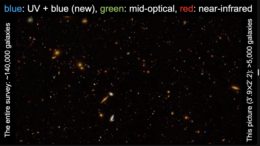
Slide from Xin Wang’s talk showing a deep field photo containing more than 5,000 galaxies. [Xin Wang/NASA/Hubble]
Last, but certainly not least, Sumner Starrfield (ASU) presented on V1674 Her — the fastest nova ever seen! Novae are particularly important, since they make all sorts of important things in the universe, like cosmic rays and lithium (which is incredibly important for our smartphones and tech here on Earth!). So, what makes a nova fast? How quickly its light dims after the initial burst. This can be an indication of a particularly massive white dwarf in the binary system that causes the nova outburst. V1674 Her broke the speed record, but that record has been broken many times — and the Vera Rubin Observatory is likely to break it again soon, as we become able to see even shorter transients with this incredible new telescope.
See live-tweets of this session here, by Briley Lewis.
Plenary Lecture: Thomas Zurbuchen (Associate Administrator, NASA Science Mission Directorate) (by Yoni Brande)
The second plenary of the day was presented by Dr. Thomas Zurbuchen, Associate Administrator for NASA’s Science Mission Directorate. Dr. Zurbuchen highlighted some of the recommendations of the recent Astro2020 Decadal Survey and argued that NASA needs to succeed in five domains in order to build effective teams and truly lead the way into the future of astrophysics.
Astrophysics as a field is at a crucial moment. The recent launch of JWST and the upcoming launch of the Roman Space Telescope are examples of the forefront of our current capabilities. The Astro2020 Great Observatories have the potential to revolutionize astrophysics, and we have to build up our communities to ensure that such missions succeed.
Communities
Zurbuchen pointed out the Decadal’s equity, diversity, and inclusion recommendations, noting that some of the NASA leaders now recognized for their pivotal contributions were fighting uphill battles when they started out decades ago. Failing to address bigotry like racism and sexism hurts people, and it also affects scientific progress. Following this, NASA recently implemented dual-anonymous peer review across its proposal streams, which has already made a significant impact in reducing gender and racial bias in awards, as well as increasing the number of awards made to early career scientists.
Focus
Zurbuchen said that NASA also needs to continue to focus on the future, even if it means ending well-loved missions. The Spitzer Space Telescope, which stuck around for years after its active coolant ran out, ended its mission in 2020, and NASA is ending the Stratospheric Observatory for Infrared Astronomy (SOFIA) in order to apply some of these resources to future projects.
Prioritize
By prioritizing strategic mission goals, Zurbuchen said that NASA can make sure ambitious projects like Mars Sample Return succeed.
Innovate
NASA has only been able to do its work because of significant technological innovation. Lessons learned from previous missions will inform future projects. If JWST was mostly purpose-built, and needed nearly a year of continuous system modeling to succeed, can NASA leverage new launch technologies and economies of scale to build cheaper, more robust observatories? Zurbuchen says yes, pointing to the massive increase in launch capability in the market now, as well as budding human serviceability and on-orbit assembly capabilities and improvements in sensor technology.
Partner
Zurbuchen outlined the partnerships NASA has made both with industry partners and international partners, both critical to current missions and future missions. Next gen telescopes will be more like JWST, with private, academic, and international stakeholders providing engineering and scientific expertise. NASA can both continue to be a leader in the field as well as a partner to help other institutions succeed. The future of astrophysics lies in collaborative science and open data.
Unite
He ended his talk with a quote from Maya Angelou: “In diversity there is beauty and there is strength.”
See live-tweets of this session here, by Yoni Brande.
Press Conference: Galactic Neighbors & Insights from ALMA (by Yoni Brande)
The last press conference for today focused on galaxies and observations with the Atacama Large Millimeter/submillimeter Array (ALMA), featuring Astrobiter Katya Gozman (University of Michigan), Eric Bell (University of Michigan), Janvi Madhani and Charlotte Welker (The Johns Hopkins University), Hollis Akins (Grinnell College), and Ambesh Singh (University of Arizona).
Katya Gozman started us off with some exciting results and a presentation titled “An Extragalactic Fossil Record: M94’s Merger History through its Stellar Halo.” M94 is a nearby spiral galaxy with a very large stellar halo, which may have evidence of past galactic mergers. In order to identify M94’s merger history, Katya and her team used the Subaru Observatory’s Hyper Suprime-Cam instrument to observe the stars in M94’s halo as well as the galaxy’s internal structure. M94 has a particularly large pseudobulge, which makes up about about half of its total mass, and its stellar halo is fairly low mass and low metallicity. If M94 had been through some energetic mergers in the past, its halo should be a lot more massive and metal rich. However, it’s not just the halos that are related to mergers, but also the galaxy’s internal structure. The team also compared M94 to another galaxy, M101. These have similar halo masses, but vastly different bulge masses, implying that M94’s significant internal structure must have been built by some other process than mergers!
Next up was Eric Bell presenting new results with a presentation titled “Building Out the Census of Faint and Ultra-Faint Satellites of Milky Way-Mass Galaxies: New Satellites-of-Satellites in the M81 Group.” His group also used the Subaru/Hyper Suprime-Cam, but studied the M81 galaxy group. M81 has several large satellite galaxies, but Eric used Subaru’s sensitivity to find lots of small, faint, unresolved galaxies in the same field. By cleverly identifying those at the same distance as M81, the team found one new dwarf satellite and several candidate dwarf satellites. These small faint galaxies will need space-based imaging from Hubble or JWST to resolve their stars and confirm their nature, but if confirmed would be among the least luminous galaxies yet found outside our own Local Group! In addition, the distribution of the dwarf satellites is notably asymmetric, centered on one of the larger satellites. Perhaps M81 tends to destroy its own satellites over time and these are more recent additions to the group.
Third in this session were Janvi Madhani and Charlotte Welker with their talk, “Are Planes of Satellite Galaxies as Elusive in Simulations as Previously Thought?” Satellite galaxies are often observed in thin coplanar streams, coherently orbiting their host galaxies. Previous simulations have struggled to reproduce these at their observed fractions. Janvi and Charlotte conducted new, higher resolution surveys to try and fix this. With the same cosmology and gravity models as previous studies and only higher resolution simulations, they were able to finally create these observed streams consistent with observations.
The last in-person presentation was from Hollis Akins and was titled “ALMA Reveals Extended Cool Gas and Hot Ionized Outflows in a Distant Star-Forming Galaxy.” Galaxies aren’t just made up of stars, but also significant amounts of interstellar gas. This gas in the interstellar medium (ISM) is constantly reprocessed into stars and replenished by supernovae, and it is also continually exchanged with the circumgalactic medium. Hollis and his team used ALMA to observe the distant galaxy A1689-zD1, which is 13 billion light-years away, in order to study its gas content. The team found very different distributions of hot/ionized and cold/neutral ISM gas in the galaxy, with compact hot gas and much more extended cold gas. This could be an effect of previous mergers, or it could be driven by gas outflows from processes in the galaxy itself. ALMA spectroscopy showed that the hot gas in the core of the center of the galaxy was being blown outward, implying that as the gas flows, it cools to form the unexpected extended neutral gas feature!
The final talk of the day was online from Ambesh Singh, titled “ALMA Reveals the Molecular Outflows in the Ejecta of VY Canis Majoris.” VY Canis Majoris is a hypergiant star with a mass greater than 20 solar masses, and it is subject to intense sporadic mass-loss events. The team searched the gaseous envelope of the star for evidence of particular molecules that may be able to trace some of these mass-loss events. Using ALMA, they were able to identify particular molecules (such as lots of carbon-bearing species, water, salt, etc.), including some that are biologically important (like phosphorus monoxide)! By taking different images at different frequencies, the team found that each molecule was associated with different expanding gaseous shells, implying they came from different mass-loss events!
See live-tweets of this session here, by Yoni Brande.
Henry Norris Russell Lecture: Nicholas Scoville (Caltech) (by Graham Doskoch)
If you look around the universe, you can tell that galaxies are an incredibly diverse bunch. There are spirals and irregular galaxies, giant ellipticals and dwarf spheroidals, green peas and luminous red galaxies. Yet in this wild and wonderful zoo, patterns emerge: trends across cosmic time. In one of this afternoon’s plenary lectures, Prof. Nicholas Scoville presented results that show how galaxy populations changed as the universe grew and evolved, viewed through the lens of a simple but ubiquitous tool: gas!
Molecular gas is extremely important. Much of it exists in the interstellar medium, with some of it lying in the form of giant molecular clouds, or GMCs. These massive structures can weigh in at hundreds of thousands of solar masses. They’re well known among astronomers for forming stars, as well as for blocking many observations within the galactic plane; the dust within GMCs causes enormous amounts of interstellar extinction. To illustrate this, Prof. Scoville pointed out that if the solar system lay inside a large molecular cloud, Earthbound astronomers wouldn’t be able to see any stars.
GMCs — or, more precisely, the gas they contain — are useful tools for extragalactic astronomers. It turns out that the mass of gas in a galaxy is related to some of its other properties. By searching for spectral line emission from GMCs, such as carbon monoxide (CO), astronomers can measure a galaxy’s gas mass and uncover these relationships. Unfortunately, at high redshifts, only certain parts of this CO emission are visible, corresponding to only the hotter gas. In his plenary talk, Prof. Scoville presented an alternative: looking for the long-wavelength spectral “tail” produced by dust within GMCs and other gas reservoirs, allowing him to trace gas in a broader range of temperatures.
By doing so, he uncovered several trends. For example, galaxies in the early universe had more gas than the Milky Way — often by factors of 10 or 100! They also had higher star formation efficiencies. This led to high star formation rates — at least until gas reservoirs were depleted; it’s a well-known trend that star formation peaked when the universe was a few billion years old, a time known as “cosmic noon.” Prof. Scoville also found that some galaxies with high star formation efficiencies were starburst galaxies, likely resulting from galactic mergers. As he pointed out, it’s possible that this is because the collisions compressed gas clouds, making it easier for them to fragment and form even more stars.
Prof. Scoville finished by acknowledging the astronomers who played a role in these studies and related projects over the years, from the team at the Cosmic Evolution Survey (COSMOS) he founded to the scientists and engineers who designed, built and operate the Atacama Large Millimeter/submillimeter Array (ALMA) in Chile, which has been instrumental to this work.
See live-tweets of this session here, by Graham Doskoch.
Laboratory Astrophysics Division Plenary Speaker: Dennis Bodewits (Auburn University) (by Pratik Gandhi)
The final plenary talk for the day featured Prof. Dennis Bodewits, who talked about “Comets as Natural Laboratories” for this year’s annual Laboratory Astrophysics Division (LAD) plenary talk. Dr. Bodewits is a professor at Auburn University originally from the Netherlands, with an asteroid (Asteroid 10033 ‘Bodewits’) named after him by the International Astronomical Union!
Right from the very beginning, Dr. Bodewits emphasised that understanding the formation, composition, and evolution of comets is crucial to a variety of endeavours, including solar system formation, planetary science, astrochemistry, geophysics, and more. Since comets are leftover building blocks from the solar system’s early days, they often encode information that can shed light on how the solar system formed in the first place. Two key questions are: (a) what are their primordial properties, and (b) how do comets evolve over billions of years?
Through observations, the community has been able to identify ~50 different atoms/molecules in and around comets, which are often extremely useful for probing the properties of the comets themselves. Dr. Bodewits then pulled out the main idea behind the talk: over scales ranging from the comet’s nucleus to its outer atmosphere, there are a few main kinds of reactions that are useful to study.
The first is resonant fluorescent emission (RFE) where “parent molecules” like H2O and CO2 come out of the nucleus, are excited by sunlight, and re-emit the light that we can then detect — this tells us how many molecules there might be. RFE can also occur from “fragment species” that occur when H2O or CO2 break up into smaller atoms/molecules. The second reaction is prompt emissive photodissociation (EP), where H2O and CO2 coming off the nucleus can get hit by sunlight immediately and split up, resulting in different energy states and spectra than from RFE. Some gases like CO2 and O2 can be studied using observations of atomic oxygen that arises from emissive photodissociation in the presence of sunlight — an example of the utility of this type of reaction. Third, we have dissociative electron impact excitation (DEIE): when H2O and CO2 coming off the nucleus get illuminated, they can emit electrons (photoelectric effect), which in turn can excite molecules and lead to very different excited states and radiation than the previous reactions.
Throughout all this, Dr. Bodewits emphasised that observing each of these reactions/effects/processes tells us different information about the chemical composition of the comet, which is why he and his group study all of them together! The final reaction he highlighted is charge exchange, where an ion encountering an electron in an atom/molecule can emit radiation in certain special cases, and often the emission can be in the X-ray regime! Dr. Bodewits explained that X-rays are usually associated with very high temperature sources, while comets are fairly cold — yet this is a case of comets showing up in X-ray emission! Charge exchange often occurs because of charged particles from the solar wind hitting the comet.
In conclusion, Dr. Bodewits re-emphasised how comets are excellent labs that allow us to study planetary science, geophysics, plasma science, chemistry, and so much more!
See live-tweets of this session here, by Pratik Gandhi.

